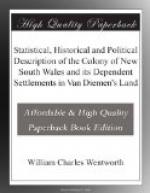Viewing therefore this newly discovered river only in the light of a river of the first magnitude, it must be evident that this important discovery will have an incalculable influence on the future progress of colonization; but to be enabled fully to estimate the beneficial consequences of which it will be productive; it is essential to take into the estimate, the probable direction of its course, and the point of its confluence with the ocean. This I have already stated is with good reason imagined to be on the north-west coast; since every other part of this vast island has been so accurately surveyed, as scarcely to admit of the possibility of so large a river falling into the sea in any other position. Assuming, therefore, that the source of this river is in the direction thus generally supposed, it will be seen that it will surpass all the rivers in the world in variety of climate; since reckoning merely from the spot where Mr. Oxley discovered it to its conjectural embouchure, there will be a difference of latitude of twenty degrees. Even omitting, then, to take into computation the probable length of its course from the place where it first becomes navigable, to the point where that gentleman fell in with it, (and it was there running from the south, and must have already been navigable for a considerable distance, if we may judge from its size,) the world does not afford any parallel of a river traversing so great a diversity of climate. The majority indeed of the rivers, which may be termed “rivers of the first magnitude,” run from west to east, or from east to west, and consequently vary their climate only in proportion to their distance from the sea, to the elevation of their beds, and to the extent of country traversed by such of their branches as run at right angles with them. Of this sort are the St. Lawrence, in North America, the Oronoko and Amazon, in South America; the Niger, Senegal and Gambia, in Africa; the Danube and Elbe, in Europe; and the Hoang Ho, and Kiang Keou in Asia. It must indeed be admitted, that every quarter of the globe furnishes some striking exceptions to this rule, such as the Mississippi and River Plate in America; the Nile, in Africa; the Rhine, the Dniester, the Don, and the Volga, in Europe; and the Indus and Ganges, in Asia; all of which certainly run from north to south, or south to north, and consequently command a great variety of climate.




